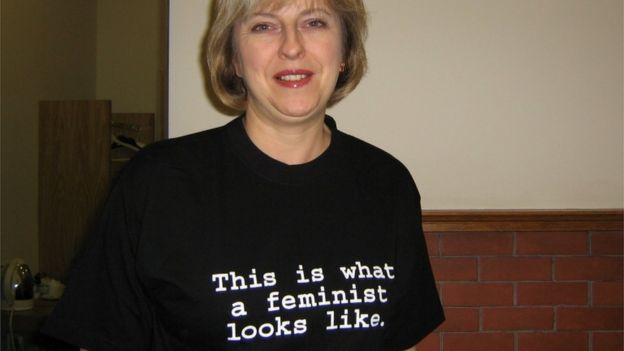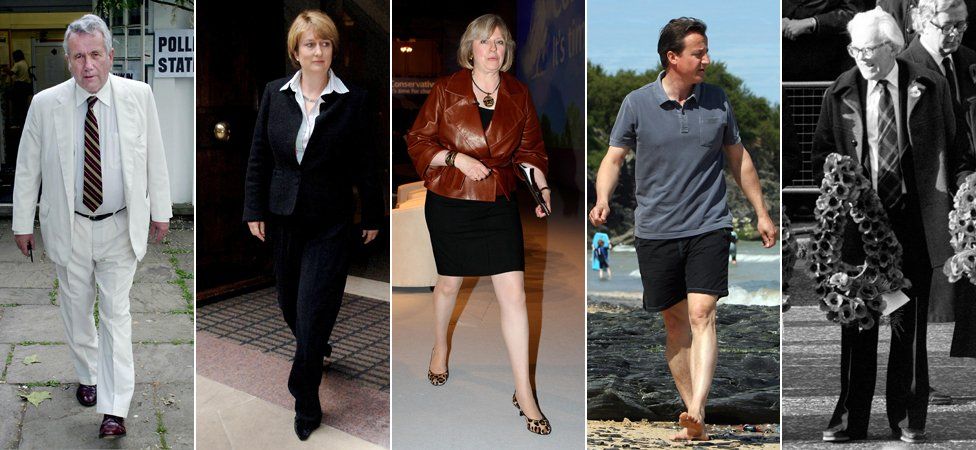From the BBC in January...above photo incuded….
Theresa May is to appear in a spread in glossy fashion magazine US Vogue, Downing Street has confirmed.
The prime minister – who is known for her love of fashion, especially eye-catching shoes – posed for the renowned portrait photographer Annie Leibovitz.
“The long-planned shoot for US Vogue will come out in April,” a No 10 spokesman said.
Baroness Thatcher, who died in 2013, was known for her smart, unfussy style including power suits, pussy-bow blouses and an ever-present handbag. [er…amongst other things?]
Oh..here’s the Corbyn supporting Daily Mirror…
If clothes could talk: What Theresa May and the other party leaders’ conference outfits said about them
When you are making your big keynote speech to your party (and the nation), it makes sense to think carefully about what you wear. So we’ve looked at the leaders’ outfits – and what we think they revealed about them.
Rightly or wrongly, the simple fact is that everyone in the public eye is judged on their appearance.
And no, before the sexism row starts AGAIN , it’s not just the women. A wise man once said that ‘clothes make the man’ and they are just as much in the firing line when it comes to their sartorial choices as women.
No denouncements and claims of back to the ’70’s over that from Corbyn?
Hypocrisy…what’s would that be then?
You must remember this from the BBC…….
Politicians have to think before they dress because of the role of television in communication with the voter.
10 sartorial moments that tell us a lot about politics
Does a politician’s appearance influence what voters think of them? Here are 10 moments that suggest that dress is important.
It’s the Easter holiday and Prime Minister David Cameron has been taking his break in Lanzarote. But attention has turned again to his leisurewear. This week Quentin Letts in the Daily Mail said the PM’s loafers gave him “beige-ja-vu” and concluded: “The best thing that can perhaps be said about them is that at least Mr Cameron wore them without socks.”
But why does it matter? Does a politician’s appearance influence what voters think of them? Here are 10 moments in fashion history that politicians might like to take note of before picking out their latest outfit….Politicians have to think before they dress because of the role of television in communication with the voter.
The Times’ diarist Michael Horsnell described Foot as being “dressed as if he had just returned from walking his dog on Hampstead Heath, in green donkey jacket, sneakers and Paisley tie”. The then Labour MP for Derby South, Walter Johnson, was reported to have called on the Parliamentary Labour Party to reprimand Foot for looking like “an-out of-work navvy” and showing “gross discourtesy to the servicemen he was supposed to be honouring”.
Michael Foot’s cautionary tale of how a single sartorial misstep could become a lightning rod for a more general deluge of mockery was not heeded by former Conservative leader William Hague. Shortly after taking the helm of the party in 1997, William Hague was skewered in the media after wearing a personalised baseball cap on a visit to a theme park.
Under Peter Mandelson’s tutelage, it was sharp suits only for Neil Kinnock – and then for Blair and his “babes,” as the press dubbed the influx of female Labour MPs in 1997, to their annoyance.
At Labour’s party conference in 2000, Tony Blair warmed to his keynote speech a little too readily and his shirt became visibly drenched in sweat. The Evening Standard was on hand to advise that he had “broken the golden rule of never wearing a blue shirt in a hot room”, while the Guardian reported the address was “more perspiration than inspiration”.
Kirsty Walker, former political correspondent for the Daily Mail and associate director of iNHouse PR, says fashion can have a bearing on politicians’ standing. “The way that politicians present themselves and the choices they make in their own lives can say a lot about their personalities – especially when political images are so carefully cultivated,” she argues.
Dr Mair from the London College of Fashion argues that, not only does presentation influence what voters think of politicians, but it can influence politicians’ own behaviour.
“What we wear makes a difference to our own cognition,” Dr Mair says. “Wearing a formal suit might actually make someone behave differently; speak more formally.”
From the German DW…..
DW: How important are a politician’s clothes?
Laura Dunn: Dress and selection of clothes are a part of politics, and a particularly important factor in the presentation of image. They help us form an opinion of the person that’s wearing them and they often become part of the character that we associate with the wearer. We all remember Margaret Thatcher for her bow blouses and structured handbags, much like we associate leopard print shoes and chunky necklaces with Theresa May. Politicians who have high profile roles are ambassadors for the country that they represent, and their choice of clothes is an important part of promoting their country.
From the FT……
No small talk, more shoes
May learnt more than a decade ago that an artfully timed style statement can speak louder than words. Ever since she had the audacity to wear a pair of leopard-print kitten heels from Russell & Bromley to berate her “nasty party” at the Tory conference in 2002, she’s mastered the art of feminine projection. The shoes in question guaranteed her a platform on every front page in the land — and well beyond it. And she’s been scooping her rivals with a statement accessory or a “controversial” look ever since. Style statements, as women instinctively understand (and men don’t need to because they rarely need to try and get a word in edgeways), ensure unwavering attention. Most people won’t remember the finer details of George Osborne’s last budget speech in March, but they do recall the spectacle of May’s plunging cleavage on the front row of the Commons. It was an excellent act of sartorial sabotage — and she didn’t say a word.
In this new age of female leadership we should expect May’s strategic wardrobe choices to dominate much of the political conversation that follows. For some, this will be a sad state of the media age we live in. Others still won’t get it. But, watch carefully, and you’ll see how her clothes tell another story, filling in the edges of her personality and revealing more about her character than many of her prewritten speeches. Rather than mask her femininity, like Hillary Clinton or Angela Merkel in their strangely asexual pantsuits and block colours, May is a graduate of the same school as Thatcher when it comes to political power dressing. She dresses to look like a woman. She confounds expectation, and works her feminine style to political advantage.
And even the Guardian is at it…telling us how important it is to dress the part….
Dressing for TV is tricky – get it wrong and the public will pounce. And the BBC presenter is hardly likely to wear her work clothes off screen.
The truth is that Williams’s appearance, particularly her screen wardrobe, really matters. To us, way more than to her. Every morning she is subject to the scrutiny of millions of bleary-eyed toast-munching viewers. She is breakfast TV’s answer to Anna Wintour with her sharp collars, her posture-enhancing belts and neat-but- approachable bob. This is no accident. Her controlled sass is as much a part of the visual package as the red sofa and the BBC Breakfast logo. Flip over to GMTV and you have Emma Crosby with a Sex and the City-style blow-dry and Kate Garraway in a Roland Mouret-alike cocktail dress, clicking perfectly with ITV’s fluffier content. Broadcaster style (for women, anyway) is important – put a foot wrong, ignore a dry-cleaning need and the public will surely pounce.






‘This is what a feminist looks like’, says her T shirt.
And this is what a Dhimmi looks like